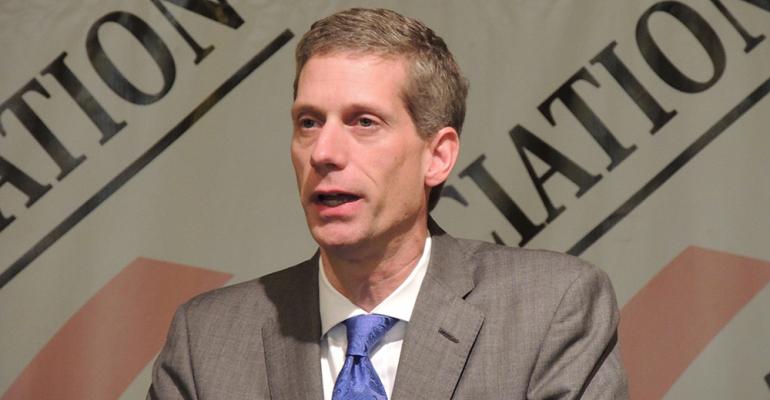DETROIT – Automotive engineers from around the world will converge here April 8-10 for the annual SAE World Congress to discuss the latest electric-vehicle charging technologies, exchange ideas about distracted driving and debate standards for autonomous vehicles.
The event is smaller than it used to be. Attendance reached nearly 50,000 in 2000 and hovered near 35,000 the next several years.
Massive downsizing and supplier bankruptcies took their toll in 2009 as attendance dropped to 16,000, and it got worse the following year after General Motors and Chrysler restructured their way through bankruptcy. In 2010, a mere 10,000 people came to Cobo Center for the event.
Attendance has held reasonably steady each year since then at about 10,000, and David Schutt is OK with that. The CEO of SAE International says he questions the reported attendance from years ago.
“I’m not sure it ever was 30,000,” he tells WardsAuto after speaking this week to the Automotive Press Assn. as a preview for the Congress. “And I’ve been trying to be more careful about who we are counting. Because you walked in the door and breathed some Cobo air does not mean you attended.”
The industry’s lean years forced SAE to rethink the event – its size, scope and target audience. In 2009, the organization became more particular about which companies could exhibit.
In prior years, as many as 700 exhibitors filled Cobo, and many of them, such as economic-development agencies, had nothing to do with automotive technology.
So SAE began screening companies that wanted to exhibit, and the number dropped to 300 in 2009 and just over 100 in 2010. The process negatively impacted attendance, and the target audience was smaller as well.
But Schutt says SAE International – a name change formalized several years ago – has been growing in Europe, China and India, so the organization will retain a “back to basics” approach to the Congress.
“It was really about getting back to technology,” he says. “Why do people come to Congress? It’s not to buy a bolt or a windshield wiper blade. They come for the latest technology.
“Years ago, if you talked to people walking the floor, they’d ask, ‘Where’s the technology?’ If you talked to the exhibitors, they asked, ‘Where are the engineers?’ So we focused on who’s here and why do they want to be here. That’s been working really well.”
Schutt is expecting 1,500 technical papers to be presented at the Congress, up from about 1,200 in 2013, and some 170 companies will exhibit on the Cobo floor. He expects attendance once again to be just over 10,000.
SAE International has 145,000 members worldwide (including 65,000 in the U.S.), and most of them work in automotive.
Hyundai is this year’s host automaker, and Delphi is the Tier 1 strategic partner, same as it was in 2007.
EVs on Docket
Electric vehicles and the infrastructure to support them will be highlighted at this year’s event. Schutt says there will be extensive discussions about wireless inductive charging, which allows properly equipped EVs to draw electricity from plates on the floor of a garage or embedded in a road surface.
“We can free ourselves from infrastructure, and it really is the holy grail we are looking for both in residential and in the public domain, whether in parking lots or curbside,” he says. “And I think the more exciting part in the whole dynamic is having it embedded into the roadway or in other areas where vehicles cross.”
SAE is working on standards in this area, particularly J2954, which will cover the inductive charging process, smart-grid interoperability, power-transfer communication, battery fault monitoring and automatic shutdown capabilities, Schutt says.
The organization has written nearly 60 standards dedicated to the EV sector. New standards also are in the works for hydrogen fuel-cell vehicles, he says.
As in the past, this year’s event will reach out to students and young professionals to ensure they see the auto industry for its many career opportunities.
“As we came through 2008, 2009 and 2010, I think the auto industry lost some of its pizzazz as the place to be. We can’t afford that in this industry,” Schutt says. “We have to be an exciting, vibrant place. So we have to focus on young professionals. We want them to grow, to develop, to experience the richness the industry has to offer, and benefit from the executives who have been around for a long time.”
SAE’s Collegiate Design Program has some 2,000 student participants each year working directly on automotive technology challenges.
“(Tesla founder) Elon Musk made the comment that he won’t hire an engineer unless he’s gone through our Collegiate Design Program,” Schutt says. “These are the students who really know how to bring things together in the real world.”




